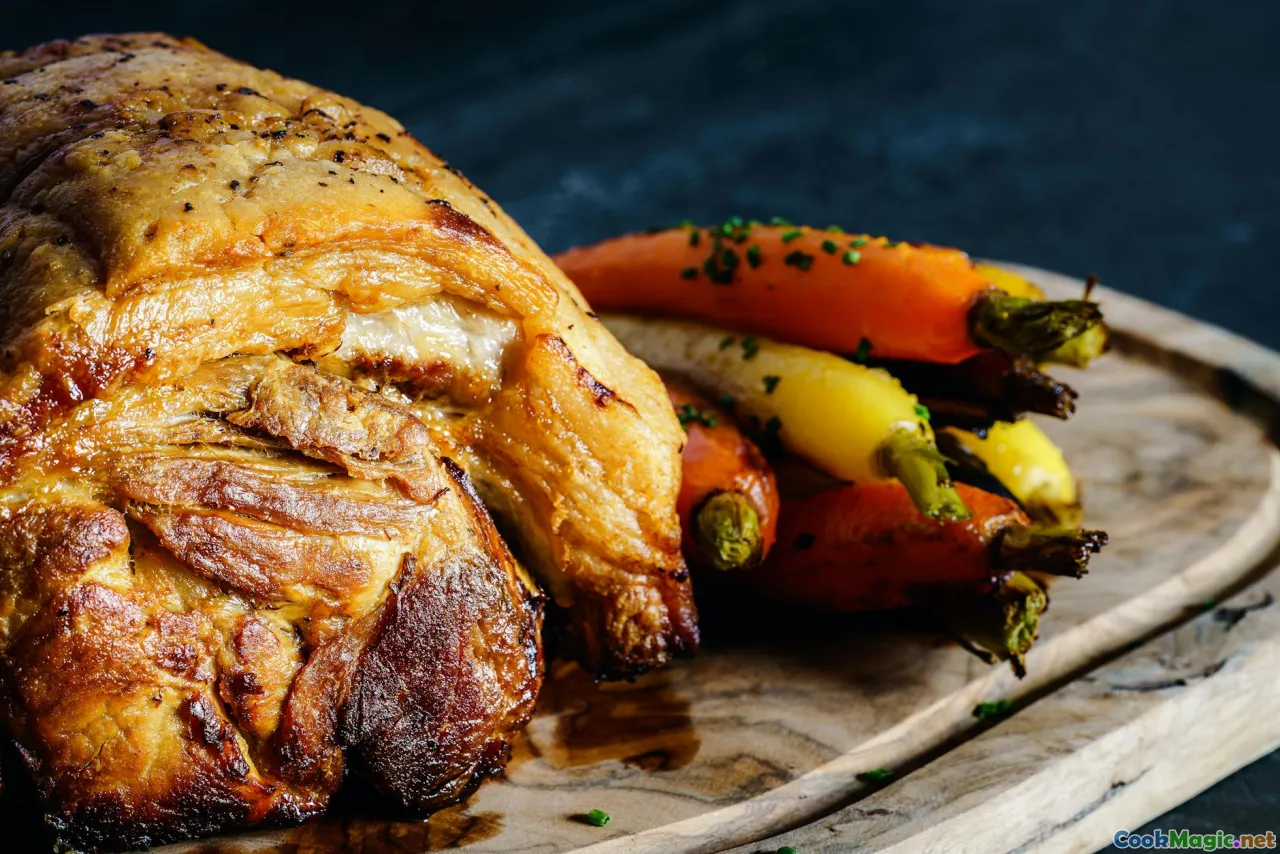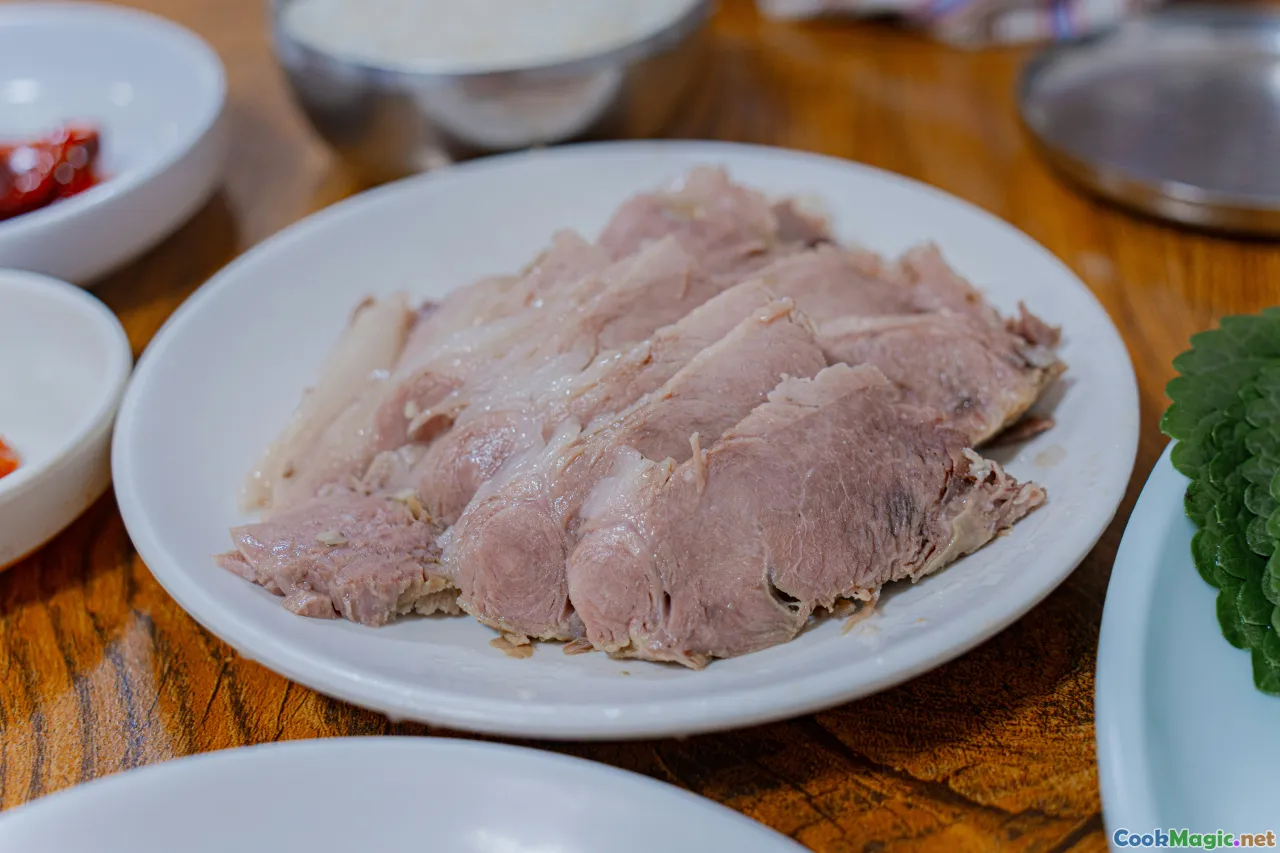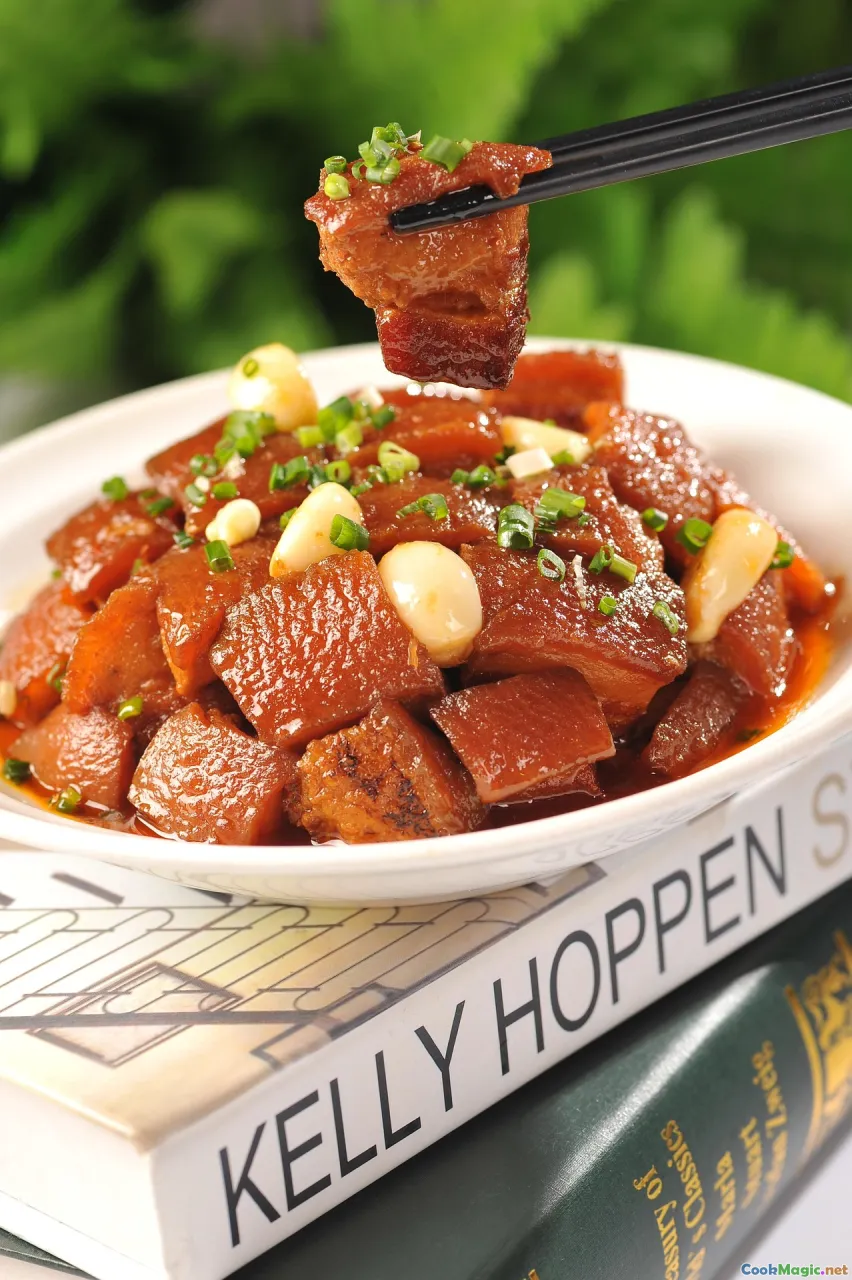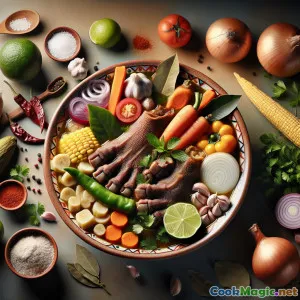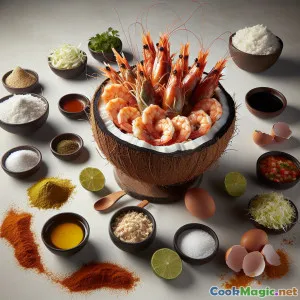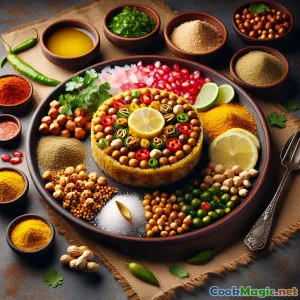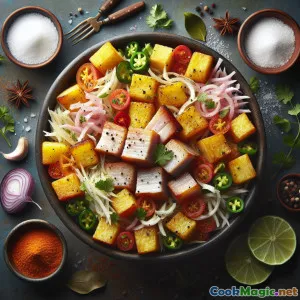
Knuspriger Maniok mit würziger Chicharrón-Salsa
(Crispy Yuca with Savory Chicharrón Salsa)
(0 Bewertungen)0
131
Oktober 22, 2025
Problem melden
Zutaten
-
1200 grams Frisches Maniok (Cassava), geschält und ausgehöhlt
(Remove the woody core; frozen yuca works too)
-
750 grams Schweinebauch mit Haut, in 2 cm Würfel geschnitten
(Look for a balance of meat and fat)
-
3.5 tsp Kashersalz
(Divided among yuca, pork, and salsa)
-
0.5 tsp Frisch gemahlener schwarzer Pfeffer
(Season the pork belly)
-
4 cloves Knoblauch (zerdrückt)
(Divided for pork and salsa)
-
1 tsp Getrockneter Oregano
(For seasoning pork)
-
60 ml Orangensaft
(Adds brightness to the pork marinade)
-
2 leaves Lorbeerblätter
(For boiling yuca)
-
500 ml Pflanzenöl oder ausgelassenes Schweineschmalz
(For frying yuca and finishing pork)
-
400 grams Weißkohl, fein gehobelt
(For quick curtido slaw)
-
100 grams Rote Zwiebel, in feine Scheiben geschnitten
(For curtido)
-
100 grams Julienne-Möhren
(For curtido)
-
120 ml Weißer Essig
(Curtido brine)
-
1 tsp Kristallzucker
(Balances curtido acidity)
-
240 ml Heißes Wasser
(To soften curtido and dissolve sugar/salt)
-
400 grams Roma-Tomaten
(For salsa roja)
-
80 grams Weiße Zwiebel, fein gehackt
(For salsa roja)
-
1 whole Jalapeño-Chili
(Seeded for mild heat; optional)
-
0.5 tsp Gemahlener Kreuzkümmel
(For salsa depth)
-
1 tsp Achiotenpulver oder süßes Paprikapulver
(Adds color to salsa)
-
15 ml Neutralöl
(For sautéing salsa aromatics)
-
15 grams Frischer Koriander (gehackt)
(Zur Garnierung)
-
2 whole Limettenviertel
(Zum Servieren)
(Remove the woody core; frozen yuca works too)
(Look for a balance of meat and fat)
(Divided among yuca, pork, and salsa)
(Season the pork belly)
(Divided for pork and salsa)
(For seasoning pork)
(Adds brightness to the pork marinade)
(For boiling yuca)
(For frying yuca and finishing pork)
(For quick curtido slaw)
(For curtido)
(For curtido)
(Curtido brine)
(Balances curtido acidity)
(To soften curtido and dissolve sugar/salt)
(For salsa roja)
(For salsa roja)
(Seeded for mild heat; optional)
(For salsa depth)
(Adds color to salsa)
(For sautéing salsa aromatics)
(Zur Garnierung)
(Zum Servieren)
Nährwerte
- Portionen: 4
- Portionsgröße: 1 Teller (300g)
- Calories: 860 kcal
- Carbohydrates: 0 g
- Protein: 33 g
- Fat: 48 g
- Fiber: 7 g
- Sugar: 8 g
- Sodium: 1100 mg
- Cholesterol: 95 mg
- Calcium: 110 mg
- Iron: 2.4 mg
Anweisungen
-
1 - Prep the yuca:
Peel the yuca thickly, split lengthwise, and remove the woody core. Cut into chunky batons. Rinse and hold in cold water to prevent browning.
-
2 - Start the curtido slaw:
In a bowl, combine cabbage, red onion, and carrot. Dissolve 1 tsp salt and the sugar in hot water, then stir in vinegar. Pour over vegetables, toss, and lightly press down.
-
3 - Marinate the Pork:
Season pork belly with 1.5 tsp salt, black pepper, garlic (half), oregano, and orange juice. Toss well and let stand while you continue.
-
4 - Render and crisp chicharrón:
Place pork in a wide pot over medium heat with a splash of water. Cover for 10 minutes to start rendering, then uncover and cook, stirring occasionally, until fat renders and cubes turn deep golden and crisp.
-
5 - Boil the yuca:
Cover yuca with water in a pot, add 1 tsp salt and bay leaves, and bring to a boil. Simmer until just tender but not falling apart, 15–20 minutes. Drain well and steam-dry.
-
6 - Finish the curtido:
Taste and adjust salt. Chill to lightly pickle while you make the salsa and fry the yuca.
-
7 - Make salsa roja:
Sauté chopped onion in 15 ml oil until translucent. Add remaining garlic, jalapeño (optional), cumin, and annatto; cook 30 seconds. Add chopped tomatoes and 1 tsp salt. Simmer until thick and spoonable; blend smooth or leave rustic.
-
8 - Fry the yuca:
Heat oil or lard to 175°C. Fry yuca in batches until blistered and golden, 4–6 minutes. Drain on a rack and sprinkle with a pinch of salt.
-
9 - Season the chicharrón:
Return crispy pork to heat briefly to re-crisp if needed. Taste and adjust seasoning.
-
10 - Plate and Garnish:
Arrange fried yuca on a platter. Top with chicharrón, spoon over warm salsa roja, add a mound of curtido, and finish with cilantro and lime wedges.
Peel the yuca thickly, split lengthwise, and remove the woody core. Cut into chunky batons. Rinse and hold in cold water to prevent browning.
In a bowl, combine cabbage, red onion, and carrot. Dissolve 1 tsp salt and the sugar in hot water, then stir in vinegar. Pour over vegetables, toss, and lightly press down.
Season pork belly with 1.5 tsp salt, black pepper, garlic (half), oregano, and orange juice. Toss well and let stand while you continue.
Place pork in a wide pot over medium heat with a splash of water. Cover for 10 minutes to start rendering, then uncover and cook, stirring occasionally, until fat renders and cubes turn deep golden and crisp.
Cover yuca with water in a pot, add 1 tsp salt and bay leaves, and bring to a boil. Simmer until just tender but not falling apart, 15–20 minutes. Drain well and steam-dry.
Taste and adjust salt. Chill to lightly pickle while you make the salsa and fry the yuca.
Sauté chopped onion in 15 ml oil until translucent. Add remaining garlic, jalapeño (optional), cumin, and annatto; cook 30 seconds. Add chopped tomatoes and 1 tsp salt. Simmer until thick and spoonable; blend smooth or leave rustic.
Heat oil or lard to 175°C. Fry yuca in batches until blistered and golden, 4–6 minutes. Drain on a rack and sprinkle with a pinch of salt.
Return crispy pork to heat briefly to re-crisp if needed. Taste and adjust seasoning.
Arrange fried yuca on a platter. Top with chicharrón, spoon over warm salsa roja, add a mound of curtido, and finish with cilantro and lime wedges.
Mehr über: Knuspriger Maniok mit würziger Chicharrón-Salsa
Why this dish stands out
Yuca con Chicharrón is a love letter to texture and contrast: fluffy-centered cassava with a shattering golden crust, partnered with pork belly cubes that crackle with every bite. It’s completed by two essential Salvadoran condiments: curtido—a quick-pickled slaw brimming with vinegar brightness—and salsa roja, a tomato-forward sauce that ties the plate together with gentle warmth and color. This combination is more than the sum of its parts; each element plays a role in balancing richness, acidity, heat, and crunch.
A brief history and cultural context
In El Salvador, you’ll find Yuca con Chicharrón served at bustling markets, roadside stands, and family gatherings. It’s a staple of comida típica, celebrated for being hearty, affordable, and deeply satisfying. The dish reflects a convergence of Indigenous ingredients and Spanish culinary techniques: cassava (yuca) long predates European contact, while pork-centric preparations like chicharrón arrived with colonization. Over time, Salvadorans crafted a uniquely local expression—pairing fried yuca with pork and refreshing pickles—to create an iconic street-food experience. On weekends, it’s common to see families sharing generous platters, the curtido’s tang cutting through the fatty bliss of chicharrón as conversation flows.
Ingredient notes and shopping tips
- Yuca: Choose heavy, firm roots with unblemished skin. When cut, the interior should be bright white without gray or black streaks. Frozen pre-peeled yuca is a reliable, time-saving alternative.
- Pork belly: Aim for a balanced ratio of meat to fat and keep the skin on for extra crackle. If you prefer a leaner option, pork shoulder works but won’t achieve the same shattering crispness.
- Curtido essentials: Cabbage, carrot, onion, vinegar, and a touch of sugar create a quick pickle that can be enjoyed within minutes, though the flavor deepens over a few hours.
- Salsa roja: Tomatoes provide body, while cumin and annatto (or paprika) lend warmth and color. A seeded jalapeño offers gentle heat without overpowering the dish.
Technique keys to success
- Thoroughly cook yuca: Cassava must be fully cooked to be safe and palatable. Boil until just tender, then drain and steam-dry before frying. This ensures a creamy interior and prevents oil spatter.
- Double texture on pork: Start pork belly with a little water, covered, to kickstart rendering. Then uncover and let the fat render until the cubes confit in their own fat and turn glassy-crisp at the edges.
- Heat control: Fry yuca at about 175°C. Overcrowding drops the temperature and leads to soggy results. Work in batches and return the oil to temp between rounds.
- Balance the plate: Don’t skip curtido. Its acidity cleanses the palate and keeps the dish from feeling heavy. A squeeze of lime just before eating adds a final bright pop.
Variations to explore
- Yuca sancochada: In some homes, the yuca is simply boiled and dressed with salsa and chicharrón—no frying required. It’s lighter but still deeply comforting.
- Plantain swap: Mix in a few slices of fried ripe plantain for a sweet counterpoint.
- Spicy kick: Swap jalapeño for serrano or add a pinch of chili flakes to the salsa roja.
- Herb twist: Finish with chopped mint alongside cilantro for a cool, aromatic accent.
Make-ahead and serving tips
- Curtido improves over time; make it up to 3 days ahead and keep refrigerated. The flavors mellow and meld, giving you a restaurant-style finish at home.
- Salsa roja can be prepared a day ahead and gently reheated. If it thickens too much, loosen with a splash of water.
- Par-cook the yuca earlier in the day. Fry to order for peak crunch.
- For gatherings, set up a platter with separate piles of yuca, chicharrón, curtido, and salsa so guests can build their perfect bite.
Personal notes
This recipe captures the joy of Salvadoran street food: food meant to be eaten with your fingers, to be shared, to be talked over. The first time I assembled it at home, I realized how the dish teaches balance—richness offset by acid, crunch supported by softness, spice tamed by sweetness. Whether you’re chasing a nostalgic flavor or discovering it for the first time, Yuca con Chicharrón rewards you with a chorus of textures and a brightness that keeps you coming back for one more piece. It’s humble, generous, and unforgettable—exactly what comfort food should be.

